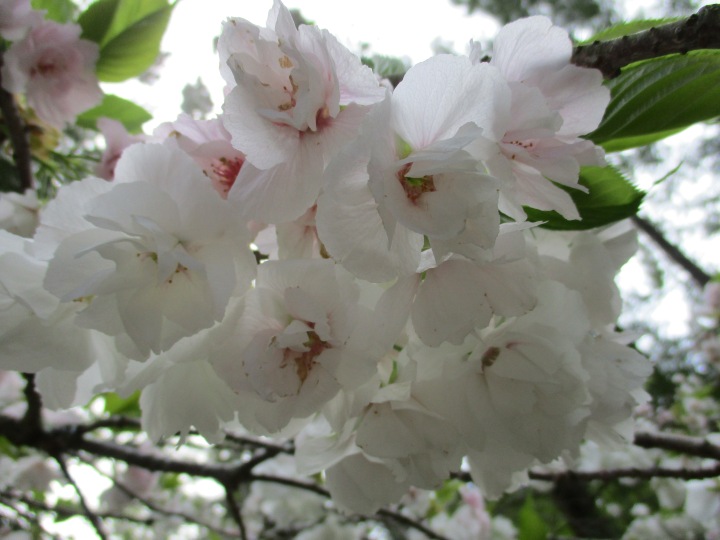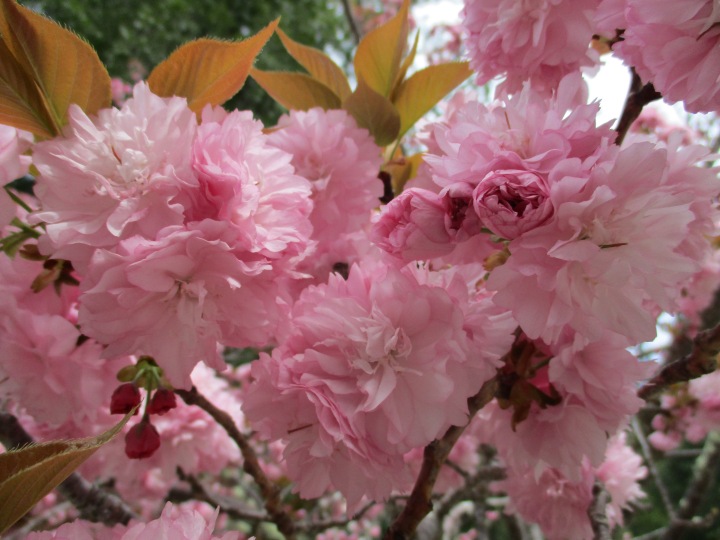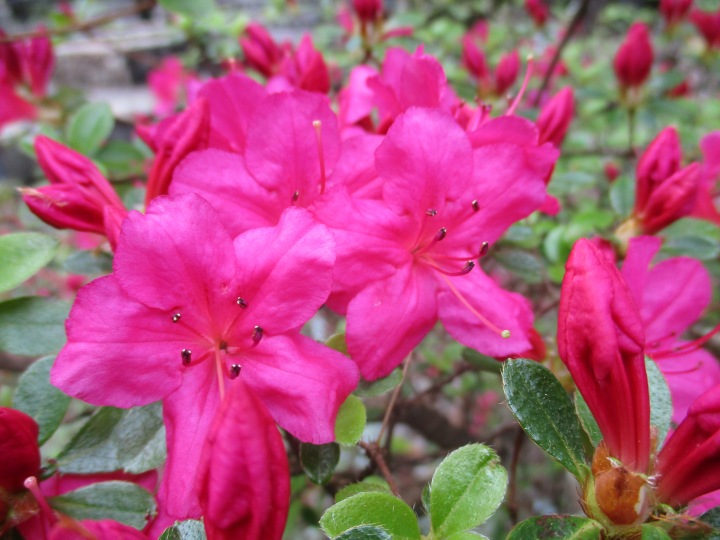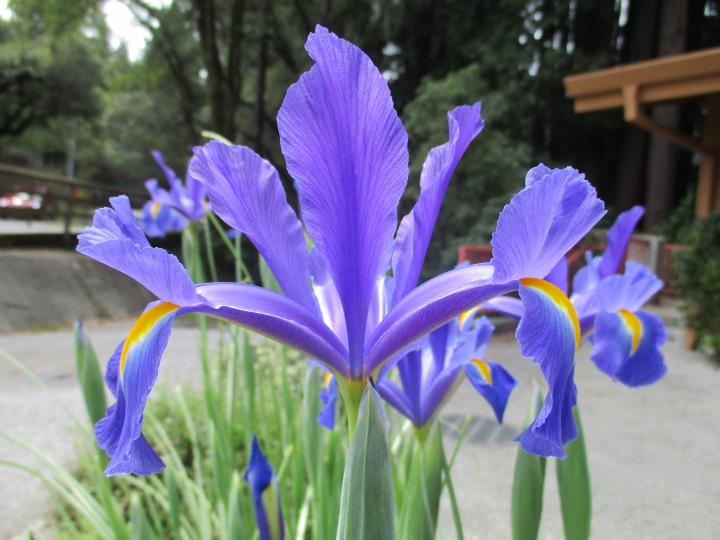The flowering cherry trees are like something from Washington D C. They are remarkably happy in our particular location. The air is a bit cooler and a bit more humid than in the Santa Clara Valley. The redwood forest protects them from wind. These pictures were taken last Monday. Bloom is finishing now. The trees in the first picture are already mostly green with new foliage. Bloom was excellent while it lasted.
Azaleas are still in full bloom in the same area. Some are farther along. Others still have buds opening. They seem to be a bit late this year.
The Dutch iris is interesting because it is so uncommon here. In other locations, it blooms well only once, and then does not get adequate chill to bloom the following year. These Dutch iris are doing quite well near the ‘Kwanzan’ flowering cherry in the third picture, and have been blooming reliable for several years.
The pansies, which are actually easy to grow here, did not do as well as other plants that should not have done as well as they did. A few bare spots are evident. However, because they are partly shaded and cooled by the redwoods, pansies can stay in this spot near the flowering cherries in the first and second pictures until the weather gets too warm for them in summer. In other places not so far away, they would have been replaced by warm season annuals already.
1. flowering cherry – Some know them as ‘Yoshino’. Others think they are ‘Akebono’. I really need to find out what they are so that we can add more before these deteriorating old trees get removed.
2. flowering cherry – Double flowers are not my favorite, but the clear bright white is. Again, we do not know what cultivar this is.
3. flowering cherry – This one is obviously ‘Kwanzan’.
4. azalea – This red azalea should be easy to identify, but no one really cares what cultivar it is.
5. Dutch iris – In our climate, this is impressively reliable bloom.
6. pansies – Yes, I know they are cliché; but they happened to be blooming near the flowering cherries, so I could not just ignore them.
This is the link for Six on Saturday, for anyone else who would like to participate:
https://thepropagatorblog.wordpress.com/2017/09/18/six-on-saturday-a-participant-guide/
A froth and bubble of beauty, Tony. Great six.
LikeLiked by 1 person
Thank you. That is an amusing way of putting it.
LikeLiked by 1 person
Love the first flowering cherry- yoshino/akebono.There is a grace to the blossom,is there not?
Do you have any tips for extending the blossom period for azaleas? I love mine,but the show is over in less than two weeks! I do deadhead- is there anything else I can do?
LikeLiked by 1 person
Flowering cherry is SO elegant, and really makes a garden seem to be more refined. (There are not many refined gardens in California.)
Two weeks is about all azaleas last for. They may not last that long if the weather ruins them. Deadheading only improves makes them prettier near the end of bloom, but does not really prolong bloom.
LikeLike
3 wonderful different flowering cherry that you showed us this morning … Thank you!
LikeLiked by 1 person
You are welcome. I would like more. People in the neighborhood really like them.
LikeLiked by 1 person
A great bunch of colour, Tommy. Loved the cherries & azalea, loved the iris but am so glad you didn’t forget the pansies. They may be common as muck, but that doesn’t mean they are gorgeous! You guys’re doing a great job. Love the scale of your posts.
LikeLiked by 1 person
Thank you. Almost all this color was there long before my time. I planted only the pansies. The cherry trees in the first picture are about as old as I am.
LikeLiked by 1 person
Beautiful pictures of the flowering cherries, Tony. I don’t see a lot of them in my area and when I do they are show stoppers. I’ve been to DC many, many times but have always missed the flowering cherry trees in the spring.
LikeLiked by 1 person
I would have thought that they would be more popular in Saint Louis because the climate is better for them.
LikeLike
Of course; as soon as I said that I saw like 3 or 4 of them today alone.
LikeLiked by 1 person
I have featured a flowering cherry too this week – not sure of the variety either. Yours are beautiful. I love the blue of that Dutch Iris and I feel sure that pansies are due a fashion comeback.
LikeLiked by 1 person
I could do without the pansies, but this is in a trafficked area. We want flowers that appeal most average people would like. We can not figure out why the Dutch iris do so well. It is one of only two spots where they survive, but the others are not quite as happy. These happy ones are in a dreadful spot, but do not mind.
LikeLiked by 1 person
Those flowering cherries are divine! Thanks for sharing.
LikeLiked by 1 person
You are welcome. After spending so much time on the farm, where so many rhododendrons bloom without anyone there to see them, it is nice to see these flowering cherries here getting photographed by guests who can appreciate them.
LikeLike
We have so much in bloom now. The Yoshinos are out and the Kwanzans are coming on; all sorts of narcissus and quite a few tulips, not to mention the Lenten roses, redbud trees, and no azaleas yet. Beautiful pictures. I’ve been taking different routes to work to and from the Metro because there are so many lovely plantings–including pansies. Pretty amazing season, spring.
LikeLiked by 1 person
Eastern redbud only appeared here in the 1990s or so, but are surprisingly popular now, which is good. They are splendid alternative to the too common crape myrtle. However, the Western redbud is surprisingly scarce. It grows as a shrub, and does not last much more than ten years, which is probably why it is unpopular. It works well on freeways because it self sows faster than it dies out. Most spring flowers are finishing now, but some of the azaleas are just starting. My favorite white ones are the first to finish.
LikeLiked by 1 person
There is an azalea in our courtyard that blossoms much of the winter. It’s blooming now, but our azaleas will come out next month. I like redbuds; while they last longer than the western ones, they are short-lived, about 25 – 30 years. Ours is hitting 40, but has some issues.
LikeLiked by 1 person
I learned only Eastern and Western in school, but found later that there are a few varieties and cultivars of Eastern, and at least one other species of Mexican redbud.
LikeLiked by 1 person
I have wondered about that. On some I’ve seen the bark is lighter. I must do a little research…
LikeLiked by 1 person
I have noticed that those with lighter and smoother bark are younger and actively growing. Older or distressed trees have more checkered bark. The Western redbud does not often get old enough to get checkered bark. It is either light and smooth, or dead.
LikeLike
It’s interesting–it may be the younger trees that are light. A lot of the older trees are dark, almost black. In fact a friend asked me once “What are those trees with the black bark and the purple blossoms in the spring?” He wanted to get one for his yard. It may well be age, rather than cultivar. I haven’t noticed a checkered appearance, but I will look (especially at ours, which gets regular arborist visits).
LikeLiked by 1 person
Nothing raises the spirits like a cherry tree in full blossom, signals that winter (hopefully) is at an end while oddly reminiscent of a tree heavy with snow.
LikeLiked by 1 person
The trees in the first picture are very popular with those who live there. They are right across the street from the Post Office. I have the very sad task of cutting dead limbs out of them this year, and perhaps eventual removal of the trees next year. We will be sneaking a new one in behind these two, but it will be decades before it amounts to much.
LikeLike